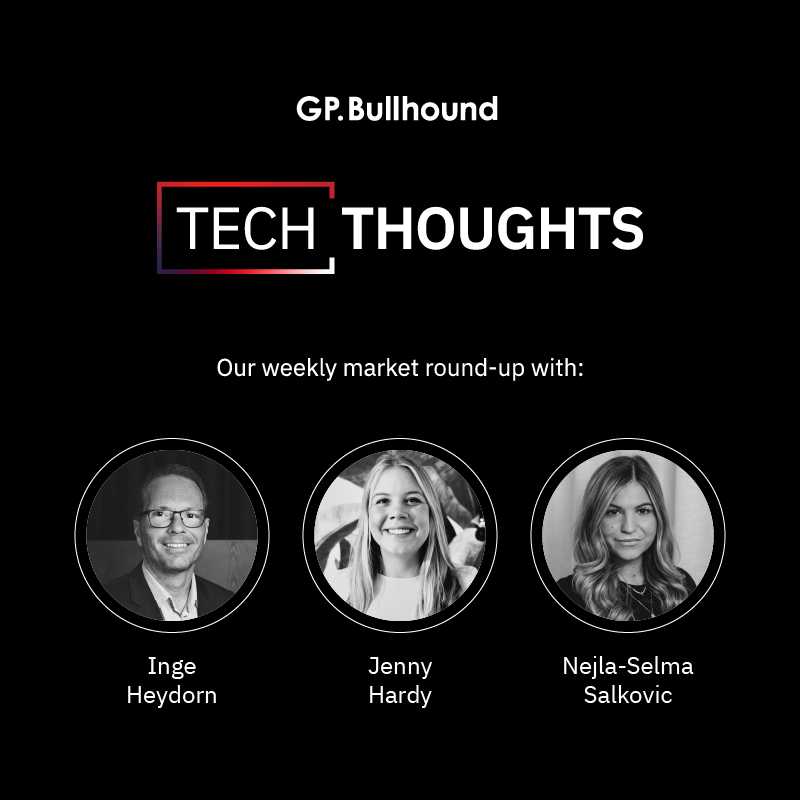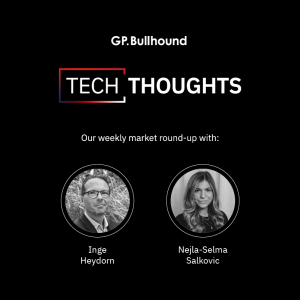Tech Thoughts Newsletter – 10 February 2023.

Conclusion: Overall, it’s been rhetoric rather than fundamentals which have really driven share price moves around results. Cost cutting is still the order of the day in tech, even if top lines remain fairly resilient.
Portfolio: We have not made any major changes to our holdings this week.
Google and Microsoft battling for AI – is Bing back?
The big news of the week has been Google and Microsoft’s AI battle and whether Google’s search business is about to be disrupted by Bing (we never thought we’d write that..).
We think making conclusions around which of Google and Microsoft is ahead in their AI capability is pretty impossible at this stage – while Google’s demo this week was panicked, rushed and full of blunders, on the surface the embedded chat capabilities (and downfalls) of both are pretty similar.
Importantly, Microsoft has nothing to lose, and everything to gain, and Nadella has been very bold in setting his stall out to try to disrupt Google. The reality is that Google’s 90% share is backed by multiple advantages: it’s been embedded in 20 years of habit; it dominates distribution across browsers and mobile, it pretty much invented many of the core technical capabilities around large language models which form the basis of chat interfaces; and it has much more data, and many more websites that are optimised around its search.
The problem Google has is that implementing a chatGPT type interface across all of its search query traffic would be mind blowingly and impossibly expensive – inference models are extremely compute intensive and some estimates we’ve seen around incremental cost per query would almost entirely destroy the profit pool of search (which is all of its business).
For Microsoft, rolling this out is a huge cost – but doable – because the number of queries it’s dealing with is an order of magnitude less. Microsoft is in a completely different starting point in that respect and so no wonder it’s making such a lot of noise.
One of the problems Google has is that its business model doesn’t monetise per query – advertisers pay if and when a user clicks on an ad. That means the high incremental cost per query of adding inference capabilities (when the vast majority of those queries aren’t monetisable) results in a cost/revenue mismatch which is a fundamental issue.
There is a scenario (though not one which we bake into our base case forecasts) in which the overall search profit pool gets eroded – where the Microsoft threat does force Google to put in a lot more cost to compete. Nadella has said that “from now on the gross margin of search is going to drop forever”. It is for sure the case that every shift Google makes towards large language model/chat interface for search, its margin is going down.
The more dramatic scenario is that Microsoft really does erode away all the profit of the industry (it has none of it to lose(!) and it’s not disruptive to its own core business model – the basic back of the envelope maths is that every 1ppt of search share for Bing is $2bn in revenue). In other words it could use profitless search as a competitive barrier/front end for its broader cloud/SaaS business… in that case maybe we’ll see Microsoft seek to outbid Google for its distribution agreement with Apple.. That would be big news indeed!
The one thing we can say with confidence though is that any erosion in the profit pool will go to chips and cost of compute.
TSMC, Nvidia and AMD (all of which we own) should all benefit. Nvidia’s investment in CUDA and the broader ecosystem is a clear advantage. AMD is undoubtedly winning out on CPUs. All (including Google’s own TPUs) are being manufactured at TSMC’S advanced nodes
AI more broadly as a competitive advantage in cloud
The other thing for us to consider is the extent to which the AI battle can bring about competitive advantages in cloud services. We know businesses increasingly want to leverage AI, and paying for that alongside compute capacity makes sense from a business perspective and each of Microsoft, Google and Amazon offers their customers AI capabilities (and their own chips). It still isn’t clear whether full stack integration is a meaningful differentiator but it seems likely to us that AI capabilities will reinforce competitive advantages (and potentially stickiness) for cloud players.
Onto other news this week:
Semis – inventory correction continuing in smartphone/PC
- We start out with the very strong January sales number from TSMC this morning which we’re still getting our head around.. +16% yr/yr and +4% mth/mth. Just 4 weeks ago, TSMC guided Q1 down 14% qtr/qtr – around an ongoing inventory correction. We don’t know what’s driving the unexpectedly high utilisation levels at TSMC in January – presumably not smartphone given what we’re seeing elsewhere from Apple and Android players. The only real swing factor we can see is HPC – Maybe the AI battle is already positively impacting the picks and shovels plays..?
- Elsewhere, monthly numbers coming out of the Taiwanese semi companies have been continuing the same trends. UMC month on month was down 6% – we expect this to come down further through Q1 as utilisation levels from and as inventory levels normalise. Largan (iPhone supplier) dropped significantly month on month (-19%) – again this makes sense – despite the supply disruptions in China, component suppliers continued to ship through Q4. That means they’re seeing their usual seasonality, while Foxconn (iPhone assembler) continues to run at full capacity catching up iPhone supply – remember Apple also has inventory to rebuild in the channel.
- Nordic Semi reported a bad set of results – it’s heavily exposed to the Chinese consumer which went through a terrible Q4 with lockdown, and where the recovery remains uncertain. That continues to be a big reason we avoid any large consumer exposure in semis.
- Skyworks – which supplies semi components into Apple and Android smartphones (mobile is 65% of their business) reported December 1Q sales down 12% yr/yr and the guidance for 2Q sales indicates a drop of 13% qtr/qtr slightly worse than expected. It’s clear there’s still inventory to be worked down in mobile, while their broader portfolio enjoyed healthy demand from automotive, infrastructure, industrial and the global shift to WiFi 6E and 7.
- The company provided a relatively reassuring message around the inventory build, though as with Nordic Semi it is very clear that the China situation is quite volatile.
- Skyworks seems to be in a relatively good position in terms of inventory and control of its own supply chain and manufacturing. The problem is that a few competitors have a slightly more difficult position and clearly elevated inventory problems in an environment of still uncertain demand.
- ARM reported results alongside its parent company Softbank, and it is expected to IPO later this year. It remains a bellwether in tech, feeding into most industries (and clearly a stronghold in mobile). Sales 3Q ending December increased 28% yr/yr to $746m while adjusted EBITDA totalled $450m, representing margins of 60% – having invested heavily to grow its position in servers, networking and autos over the past several years it is back to similar levels of margins it saw as a listed company.
- Arm’s growth appears to be defying the current slowdown and it continues to outship the overall market. While it still has a very small share in datacentre vs x86 from Intel and AMD,many of the inhouse hyperscaler chips are built on Arm architecture (AWS Graviton) and it’s clear that it’s expertise and legacy in low powered smartphone chips has relevance in specific server and datacentre workloads.
- Compal and Quanta both reported yr/yr and mth/mth declines in January sales reflecting the still very bad picture in the notebooks market
- Mediatek reported Q4 – it had already reported solid sales for the quarter but this was important as a first look at its balance sheet and inventory situation. Its inventory is still high but has gone down sequentially in Q4, showing its lower wafer starts having some impact. Its commentary on the channel was less reassuring – it’s still seeing smartphone inventory at about 3-3.5 months which still has a way to come down. Again, the China demand recovery post reopening remains a big uncertainty in its future demand picture.
- SMIC reported this morning. Q4 results came it at the low end of guidance as China demand weighed. Despite lower utilisation, inventories are still going higher, and they guided the full year down low teens. Overall not a super healthy picture. The capex guide is still for flat spend on 2022 – which is very positive for us on semicap given the fears around US restrictions – it’s clear SMIC is still spending on trailing edge nodes – we think to build capacity out for industrial and auto.
Auto semis still the bright spot
- General Motors signed a long term supply agreement with GlobalFoundries. GM said its semiconductor requirements will more than double over the next several years as vehicles become technology platforms. The details of the agreement are still unclear but perhaps 1) GM will start to design and have GFC manufacture these chips; or 2) GM is securing foundry capacity sources for its fabless chip suppliers; or 3) this just a political side show to support the CHIPS and Science Act. Anyways, worth seeing if other car makers will do similar things, and a development to put on our radar screen.
- Renesas’s auto business was up 29% yr/yr in Q4 and inventories were down qtr/qtr – again just showing the very different set up and health of the industry (vs. smartphone above)
Our view: monthly sales reports will continue to show inventory adjustments continuing across consumer semis. There are some positive signs (from Skyworks) that there was meaningful progress in inventory digestion in Q4, but as we’ve said before there’s still a lot of uncertainty around the real trajectory of demand (which China weakness compounds). Apple inventory restocking should provide a bit of a buffer in the short term, while Android still needs to work through, then we maybe looking ahead to the September quarter we should be at more normal sell-in. Autos remains the area we prefer to be exposed to in the component space (we own Infineon and NXP)
Semicap
- A couple of results in the value chain from smaller companies – Formfactor provides test and measurement equipment into the semiconductor manufacturing space (so feeding into the same capex spend as our semicap equipment businesses) and it reported very solid results, with very robust demand from domestic Chinese semiconductor companies – again echoing our view that China continues to invest, even if they are restricted at the leading edge.
- Axcelis, which provides ion implantation solutions into the semi industry reported strong results (having positively pre announced at the start of the year). China represented its biggest market in Q4 and 2022, and its power devices business and SiC which is showing particular strength. Like most players they expect sales to step down in Q1 after a very strong Q4, and then to recover.
- Tokyo Electron’s latest reported quarter was messy around its own inventory management issues, but having cut its guidance for the year ending March back in November, it’s raised it again. It expects 2023 WFE market to be down 20% yr/yr – in line with our expectations and it does feel like market expectations have stabilised to better levels after a lot of noise around China restrictions late last year. It expects 2024 to be a growth year.
The broad advertising market is holding up well – contrast with digital where share losses to new competition and ATT remains a headwind.
- Omnicom followed the strong results we saw at Publicis last week, Q4 growing 7.2% yr/yr and a guide of 3-5% yr/yr. It all shows specific headwinds for individual players in the digital advertising space vs. necessarily a broader macro slowdown.
- Following Facebook, Google and Snap’s lacklustre toplines (all declining) last week, Pinterest’s growth slowed to 4% and guided to low single digit growth in Q1 and talked of softening demand lowering ad pricing across the industry (which we think may be more about increasing competition and inventory.)
The gaming market largely turned out as we expected in 4Q, the big titles stole the show. Call Of Duty, Gods of Ragnarök and Pokemon series from Nintendo.
- The overall market remains weak which means that given that these 3 titles outperformed strongly, even less was up for grabs for the rest.
- TakeTwo was one of the victims of the above trends, with no new big releases, and it missed on bookings for the December quarter. The company also guided down bookings for the full year ending March 2023.
- More positively it noted some signs of stabilisation in its mobile business (Zynga) after a very weak period.
- Activision (owned) results were clearly better than market expectations, bookings totalled USD3.57bn up from 2.49bn last year and above consensus of USD3.08bn. The driver of the growth was Call of Duty having its best season ever after the weak year last year.
- Nintendo (owned) sales fell 1.9% Y/Y in 3Q and ordinary profit fell 6.1%.
- Sales of software increased due to larger installed base and the success of the Pokemon series while Switch sales declined more than expected. The weaker sales development led the company to cut their guidance for console shipments for the year to 18m from 19m and also trimmed software sales downwards slightly.
Our view: We expected a very strong Call of Duty season given various industry datapoints we’d tracked in the quarter. We still believe that even if the bid from Microsoft fails (there was more noise from the UK this week), the valuation of the company at these levels is attractive. We continue to believe in the large franchise gaming businesses ability keep capitalising on new releases and longer term new forms of gaming and a larger future TAM – we own Activision, Nintendo and Sony.
Cybersecurity demand holding up
- Fortinet 4Q sales increased 33% yr/yr just below expectations. EPS beat. The company is guiding 1Q sales ahead of consensus and the guidance for the full year sales was also slightly above expectations. The call spoke to still robust demand
- We believe that Fortinet is clearly winning share as a wider and more cost efficient supplier especially in networking and SD-WAN. The spending on cyber security seems to be holding up well. Good read to Palo Alto’s (which we own) Firewall business.
For weekly insights on the latest market updates, please subscribe to our Tech Thoughts podcast.
For more information about Tech Thoughts, please visit https://www.gpbullhound.com/tech-thoughts/.
We provide investors with access to category leading technology companies, globally. Our assets under management have a total value of more than €1bn, and our limited partners include institutions, family offices and entrepreneurs. Learn more about our funds here.
Enquiries
For enquiries, please contact:
Inge Heydorn, Partner, at inge.heydorn@gpbullhound.com
Jenny Hardy, Portfolio Manager, at jenny.hardy@gpbullhound.com
Nejla-Selma Salkovic, Analyst, at nejla-selma.salkovic@gpbullhound.com
About GP Bullhound
GP Bullhound is a leading technology advisory and investment firm, providing transaction advice and capital to the world’s best entrepreneurs and founders. Founded in 1999 in London and Menlo Park, the firm today has 13 offices spanning Europe, the US and Asia. For more information, please visit www.gpbullhound.com.

